
Anyone can say they’re the best at what they do, but not everyone has the evidence to back up their claims.
That’s why case studies are so powerful—they show credible evidence, rather than simply telling people you do good work. A well-written case study can be an influential driver of leads and sales.
Case studies showcase the exact challenges you’ve helped your clients overcome, the solutions you’ve offered, and the lucrative results you’ve generated for your customers.
However, crafting a strong narrative takes skill. Read on for tried-and-tested case study writing tips to kick-start your creative process, and convert leads into customers.
6 Steps to prepare a winning case study
First, let’s go over how to gather data, quotes, and more to get ready to write your case study.
1) Determine your target audience
Before you begin to draft a case study, understand why you’re writing it and who it’s meant to appeal to. This type of strategic approach lays the foundations for a case study that resonates with your target audience and positions you as an expert in your field.
If you’re writing a case study for a company you’ve worked with for a while, it’s likely you know this information intuitively. However, if you’re writing case studies on a project-basis for new clients, you’ll need to learn their different audiences and which one this case study is meant to attract and convert.
Laying the groundwork of understanding your audience will help guide how you approach every subsequent step in this process. For example, if you know you’re speaking to a B2B audience, you may remember to ask questions about data security to get buy-in from a legal team.
2) Decide your case study focus
There are two ways you can approach writing a case study:
- Hyper-focus on an angle you want to showcase, ruthlessly cutting out everything that is superfluous to the narrative to direct readers toward a powerful main conclusion.
- Share everything and see who it connects with, with the goal of ensuring at least one section of your case study catches a prospect’s attention.
Taking a narrow approach
In the first option, you decide exactly what you want to “sell” with your case study. For example, you might want to showcase a new product or feature, or break into a new market segment that you must build credibility with.
You may want to showcase leading brands you’ve supported and share complex challenges you’ve resolved.
These case studies help establish your credibility and offer proof that you’re well equipped to handle specific challenges, serve certain industries, and execute exact processes.
Sharing the broad view
On the flip side, if you’re a smaller company or do many things for most of your clients, the second approach may be better suited to you.
With this method, your initial writings will revolve around clients who are willing to share their experiences. As such, your client’s profile (industry, challenges, goals, and outcomes) will dictate the ideal audience for your case study.
Your case study will focus on highlighting this client’s experience so it resonates with prospects who are experiencing similar situations, problems, and goals.
3) Choose the customer or project you want to spotlight
Once you’re crystal clear on who you want to reach with your case study, and how you want to approach the story, it’s time to choose which customer to write about.
The ideal customer to showcase…
- Has an impactful story to tell
- Has agreed to be featured in a case study
- Can provide impactful before and after data
Your featured client should be relevant to your target industry and someone you’ve secured excellent results for. This is a great way to show new prospects you’ve helped other businesses just like theirs.
Make your customers and their achievements the star of the case study by highlighting what they do, why they are a great company to know of and patronize, and how you fit into the picture. Sharing customer specifics also adds a layer of trust and authenticity to your content. If it’s a well-known and respected name in the industry, that’ll speak volumes about the type of companies you achieve results for.
Tip: If you can’t mention a company by name, but still want to showcase some impressive results you’ve achieved for them, consider exploring an anonymous case study. Focus on the customer experience and outcomes accomplished without disclosing their identity. You can describe the company in broad terms, what you did for them, and the results achieved in percentage gains that still protect exact numbers.
4) Gather data internally
Case studies are a fantastic opportunity to let numbers do the talking. The data you collect has the power to transform your article from merely stating what you do to proving it through hard facts.
Data gives people context, providing the nitty-gritty detail that brings your case study to life. Make a habit of collecting data from every client. Track key metrics before, during, and after you’ve worked with them so you can then incorporate strategic proof into your case studies. A case study that says, “We increased their conversion rate by 76%,” is much more compelling than one with a vague, “We increased their conversion rate.”
Use the information gathered to paint a before-and-after picture of the case study. Data concerns more than numbers — it showcases progress, improvement, and success. Infuse your case study with reliable data and feature visuals like bar charts so readers can easily see the results achieved.
Tip: Before speaking with your customer, interview their account manager, speak with team members that interact with the customer regularly, and review customer data on hand with your data analyst. This will give you a clear picture of your impact on the customer’s business (sometimes beyond even what the customer knows), which should guide your questions and help ensure you cover everything you want to in the interview. No more missing out on quote opportunities!
5) Interview your customer
Interviewing customers is my favorite way to gather valuable insights. Customer interviews let you capture deeper, qualitative data that you can’t gain from crunching numbers and looking at metrics.
Leverage interviews to explore the original challenge or goal that led clients to hire you. This is a great opportunity for the customer to reflect on why they chose to work with you and how your solution has since helped. Take the opportunity to ask more probing questions as well; use open-ended inquiries and encourage the customer to expand on their answers.
For example, you could ask them a series of questions like:
- What problems were you experiencing when you started to look for help? Can you tell me more about that?
- How has our solution helped your company? What specific successes have you achieved as a result?
- How are our companies aligned? Why does that matter to you?
- What was your process before we worked together? What were the challenges with that approach?
Pairing your initial question with a follow-up is an effective technique for encouraging people to divulge more information.
When speaking with your customer, record the interview (after informing them in advance). That way, you can replay the conversation to pull out any long-form quotes to use as testimonials in the case study. Plus, it saves you from having to physically write down or remember everything they said.
Get my case study question bank here.
6) Collect testimonials
Testimonials strengthen your case studies by adding the customer’s voice to the narrative. A second point of view backs up your claims with influential social proof.
You can gather testimonials during customer interviews, regularly as you work together, and during your post-project process. If you run projects with a clear closing date for clients, it’s vital that you ask for reviews and testimonials during your hand-over and offboarding.
When you wrap up a project with a client, ask them for feedback on their experience. If it takes a while to realize results, set up a check-in call in advance. This is a great way to catch up with past clients and discuss your performance and the impact the project has had on their business. It could also be an excellent segue into securing future projects.
If you have an abundance of testimonials, be picky in your selection. You want them to have the greatest impact on your readers, so focus on reviews that show standout results or directly address your audience’s challenges and goals.
Create your case study structure

After laying the foundations for your case study with audience research and customer data, you can start planning the structure.
I recommend including the following sections in your case study:
- Title
- Introduction
- Problem
- Solution
- Outcome
You can also follow that structure in different subsections. For example, having one section of a case study focus on one problem (complete with intro and solution), and then moving to the next.
Let’s look at each section in more detail.
1) Title
While we might say not to judge a book by its cover, people definitely judge a book by its title. This means your case study title carries much of the load of drawing in readers. Advertising tycoon David Ogilvy found that “five times as many people read the headline as read the body copy.”
So, if you want people to read your case study, you need a compelling title that piques interest and encourages clickthroughs to read the full case study.
A title that reads “[brand name] case study,” for instance, tells the reader nothing about what to expect. On the other hand, a case study titled “How we helped [brand name] up their sales by [percentile increase] with [tactic]” is much more informative and interesting.
Craft an engaging case study title by:
- Emphasizing the initial challenge and hinting at how you overcame it
- Offering hope in the form of an actionable solution
- Creating intrigue with powerful statistics to show the impact of the solution
- Adding a quote snippet that shows the customer’s delight with the outcome
2) Introduction
The introduction is your chance to hook readers and entice them to keep reading. It also gives readers context so they know what to expect.
Give a brief overview of the project completed and the results achieved. This tempts your target segment to dive deeper into the details of the case study to learn how you helped your customer overcome their challenges, which the reader may be facing themselves.
3) Problem
You’ve set the scene with the introduction. Now, it’s time to share the problem the customer faced before they worked with you.
Use this section to describe the client’s challenges and the impact they had on their business. This additional context can add an emotional aspect to your story as the reader empathizes with the customer’s situation.
You can also explain past solutions they may have tried and why those didn’t work. By laying out failed alternatives, your reader is more likely to consider working with you rather than adopt another potential solution.
4) Solution
After you present the problem, share the solution you developed. This is your answer to the challenge or problem the customer was experiencing.
In your description, explain any services provided, tools used, and timelines. Detail the process to help people understand the finer workings of the case study. While you don’t want to reveal all your secrets, sharing some of the more minute elements of the project could work in your favor.
You can also capitalize on this section to explore any new challenges that arose during the project and how you overcame them.
5) Outcome
Finally, the narrative of your case study should draw to a close by detailing the outcome. In this section, pinpoint specific results your client achieved.
Remember that data I told you to gather earlier? This is the perfect place to weave it into your case study. Share standout metrics that highlight achievements from the project. Clearly express how your work helped bring these results to fruition. I like using bullet points for the outcome section because they make the information easier to digest; they share simple, bite-sized data points that speak for themselves.
If you continued working with the client after the project, mention that as one of the outcomes or next steps too. It’s a good way to let people know you’re available for ongoing retainer work or additional projects.
6 Tips for writing your case study
Research? Check! Structure? Check! With those things boxed off, you can now start writing your case study.
You achieved amazing results for your client, so it’s crucial that your case study displays that impact. A bland or complex article that simply rattles off information won’t cut it; your case study needs to take the reader on a journey. Make it easy for readers to digest the information, visualize the results, and get in touch with you about working together.
To make sure your writings drive lucrative leads and conversions, I’ve included a few proven best practices for creating high-converting case studies.
1) Tell a story
Anyone can present facts and information, but spinning those facts into a story is what makes your case study memorable. April Dunford is a master of product positioning and believes positioning and storytelling go hand in hand. Learning how to tell the story behind your case study helps keep readers attention and makes the facts more impactful.
You can employ a variety of storytelling techniques to craft a stellar case study. An effective tactic is to put your customer at the heart of the narrative using Joseph Campbell’s hero’s journey copywriting technique. This strategy guides the reader from the initial problem (their “call to adventure”) to the triumphant results (the hero’s return).
Along with storytelling techniques, weave emotion into the case study. Pull on the reader’s emotions by highlighting familiar challenges, building to a climax, and making the narrative relatable and interesting. Case studies shouldn’t be boring — have fun with them!
Below: Moz does a great job of painting a picture as they tell the story from their customer’s perspective.
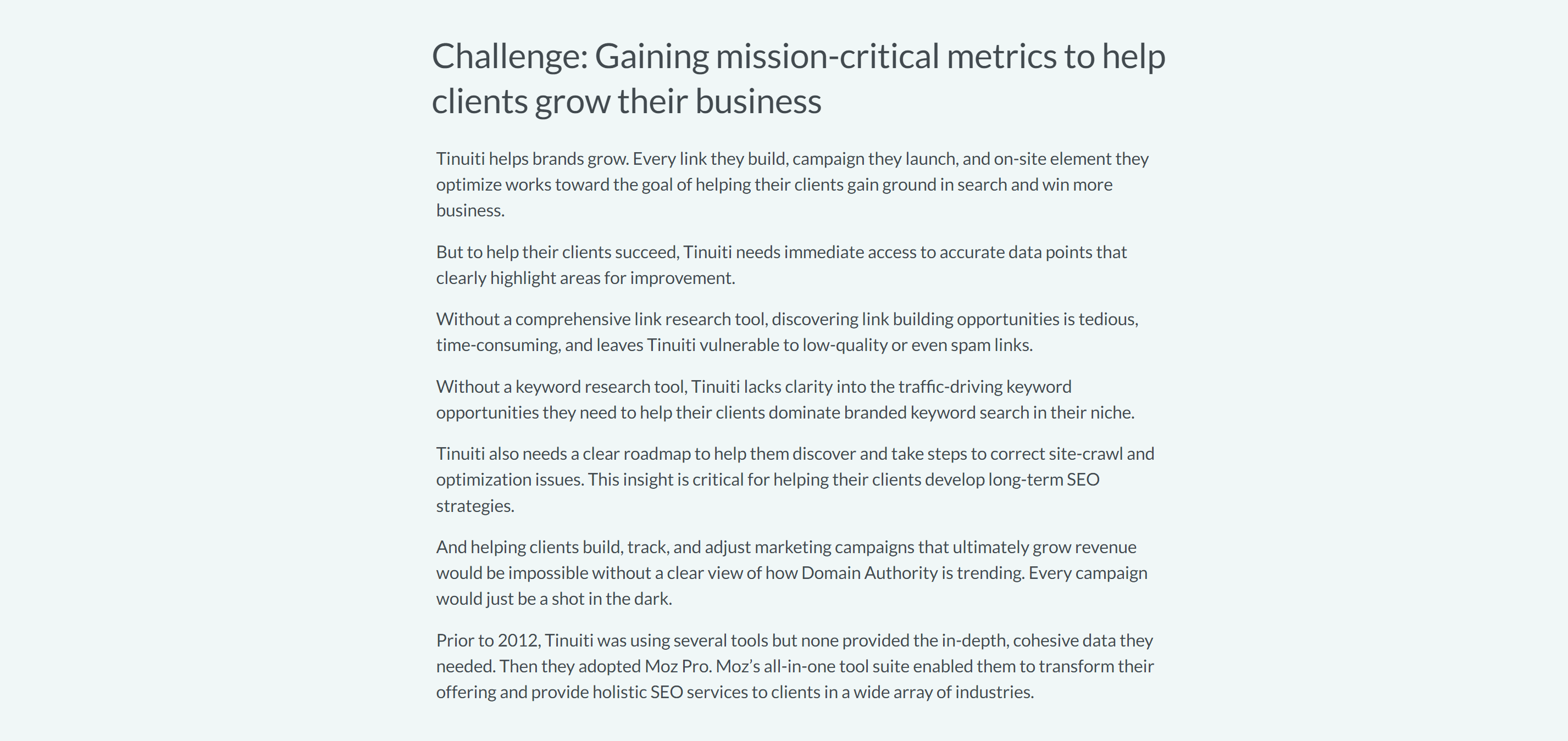
2) Have three key points
Three is the magic number, just ask “Schoolhouse Rock.” In writing, the rule of three draws on the rhythm and flow of language by using a numbered pattern.
When writing your case study, focus on a maximum of three key elements. They could be benefits that came from the project or a combination of outcomes achieved and the provided solution that other alternatives may not have been able or willing to accomplish.
Your three key points should summarize the main takeaway behind the case study. As such, they should also be relevant to your target audience.
Below: Great Place To Work uses the rule of three throughout their xDesign case study, sharing three key survey scores and three key solutions.
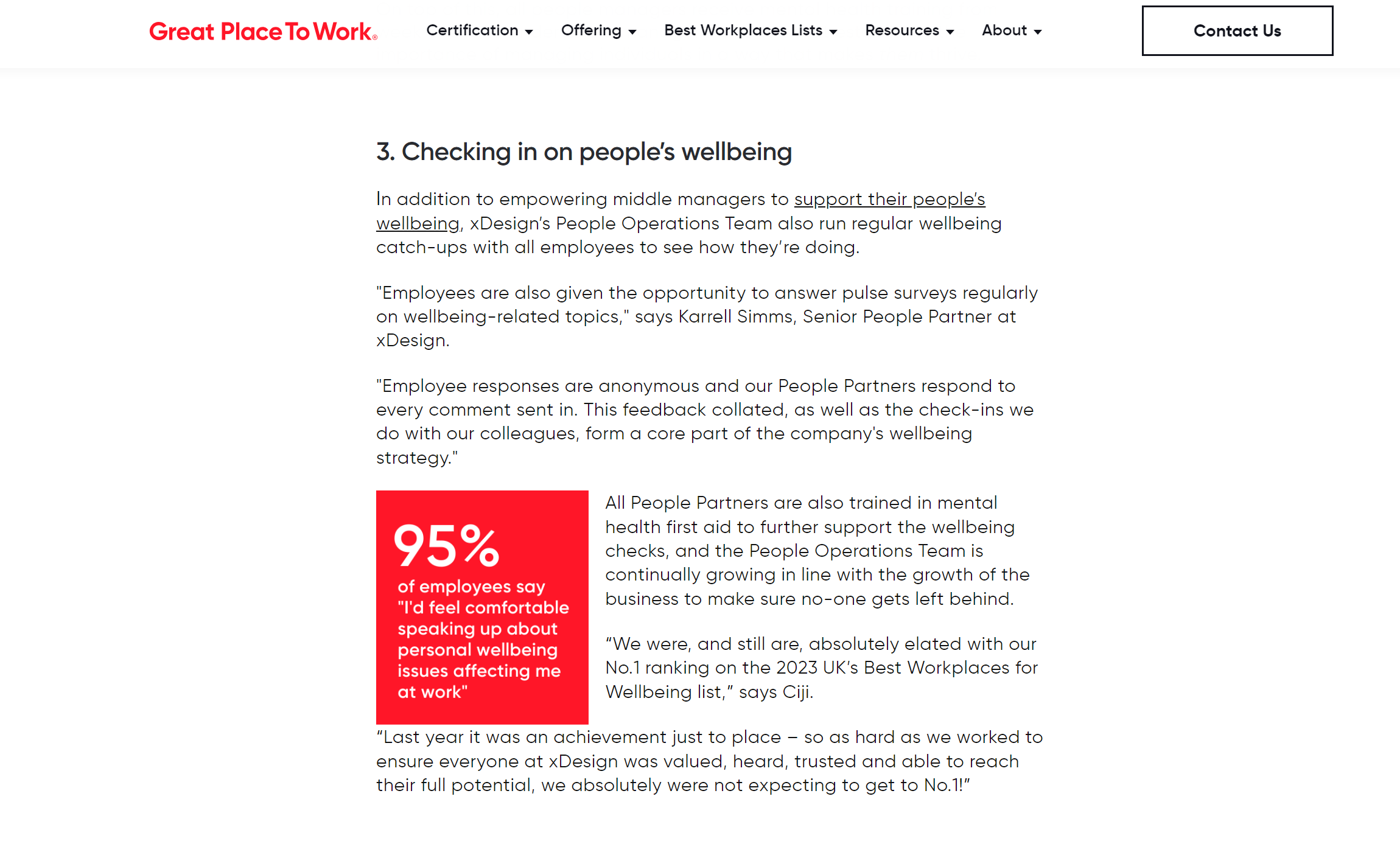
3) Carry the reader from the problem to the solution
The structure I shared earlier that guides the reader through the stages of the project follows the problem-agitation-solution (PAS) copywriting technique. That progression is great for building suspense and maintaining engagement.
As you write the case study, put yourself in your customer’s shoes and tell the story from their perspective. It can be easy to fall into the trap of narrating from your point of view as the service provider. Your target audience, however, will be able to build a stronger connection with your customer, so follow the journey of problem to solution through the eyes of the client.
The transition from problem to solution positions your services or products as the answer to readers’ challenges and builds a compelling case for why they should choose you.
Below: Logitech uses a short yet effective method for swiftly taking readers from the challenge to the solution.
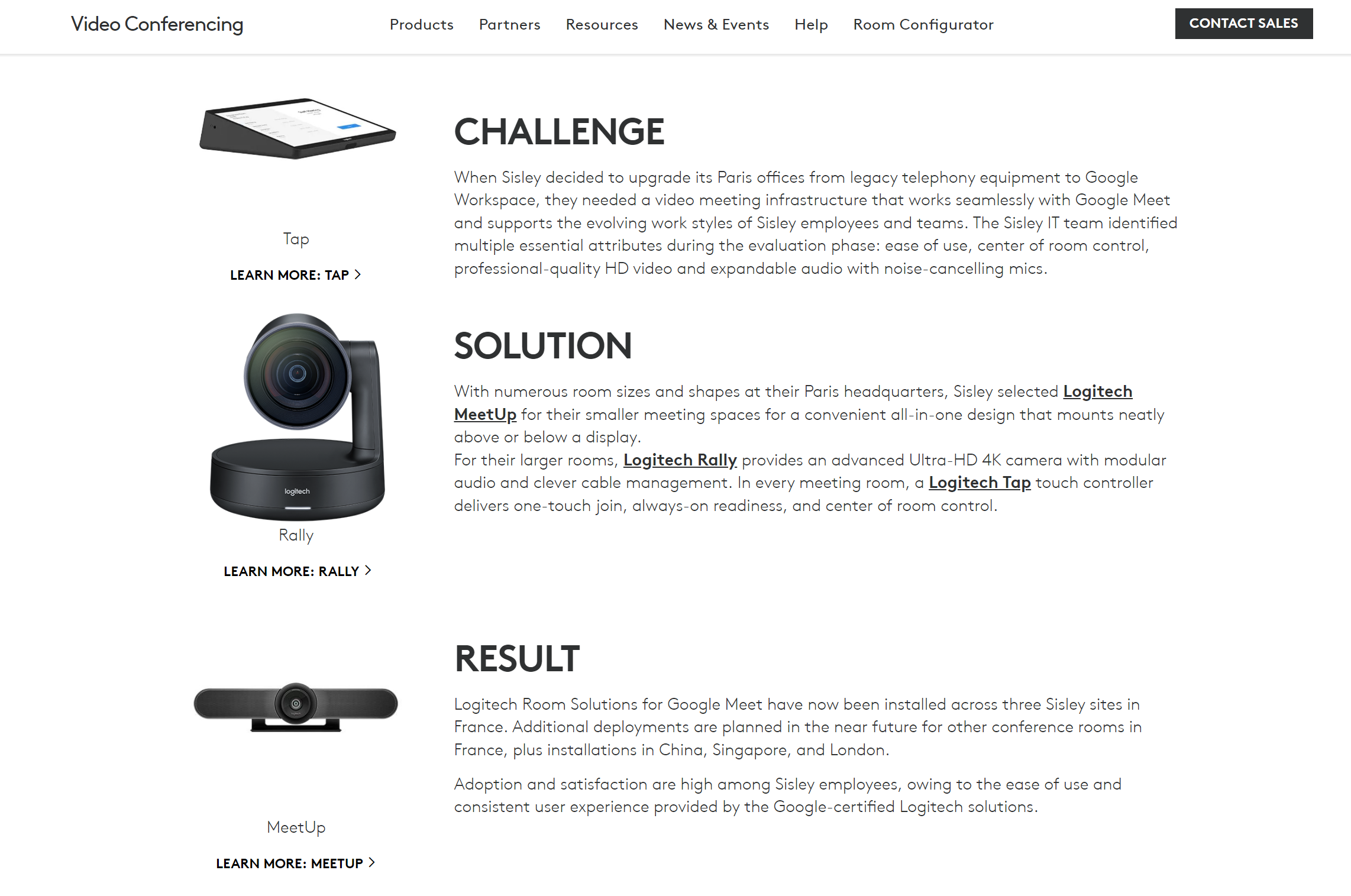
4) Make it visual
The best way to show off the results achieved is by visualizing them.
Use media like photos, videos, screenshots, charts, and graphs to make your case study information easy to digest. It’ll also add an engaging and creative flair so your article is more memorable for your audience.
Data visualizations can seamlessly communicate your results. Create charts to show key metrics before and after the project so readers can instantly see the success of your solution.
Photos and videos of the work delivered let your readers see what you did to supplement your words. You can also use a series of photos to walk your target audience visually through the case study’s journey.
Sharing your customer’s brand logo or photos is another way to add a visual touch. If your customer is a well recognized brand, featuring their logo and brand images in your case study shows people the caliber of clients you help and tells them you’re well equipped to help them too.
Below: Contently highlights their case study results in an eye-catching graphic to the right of the article, and even includes a video.
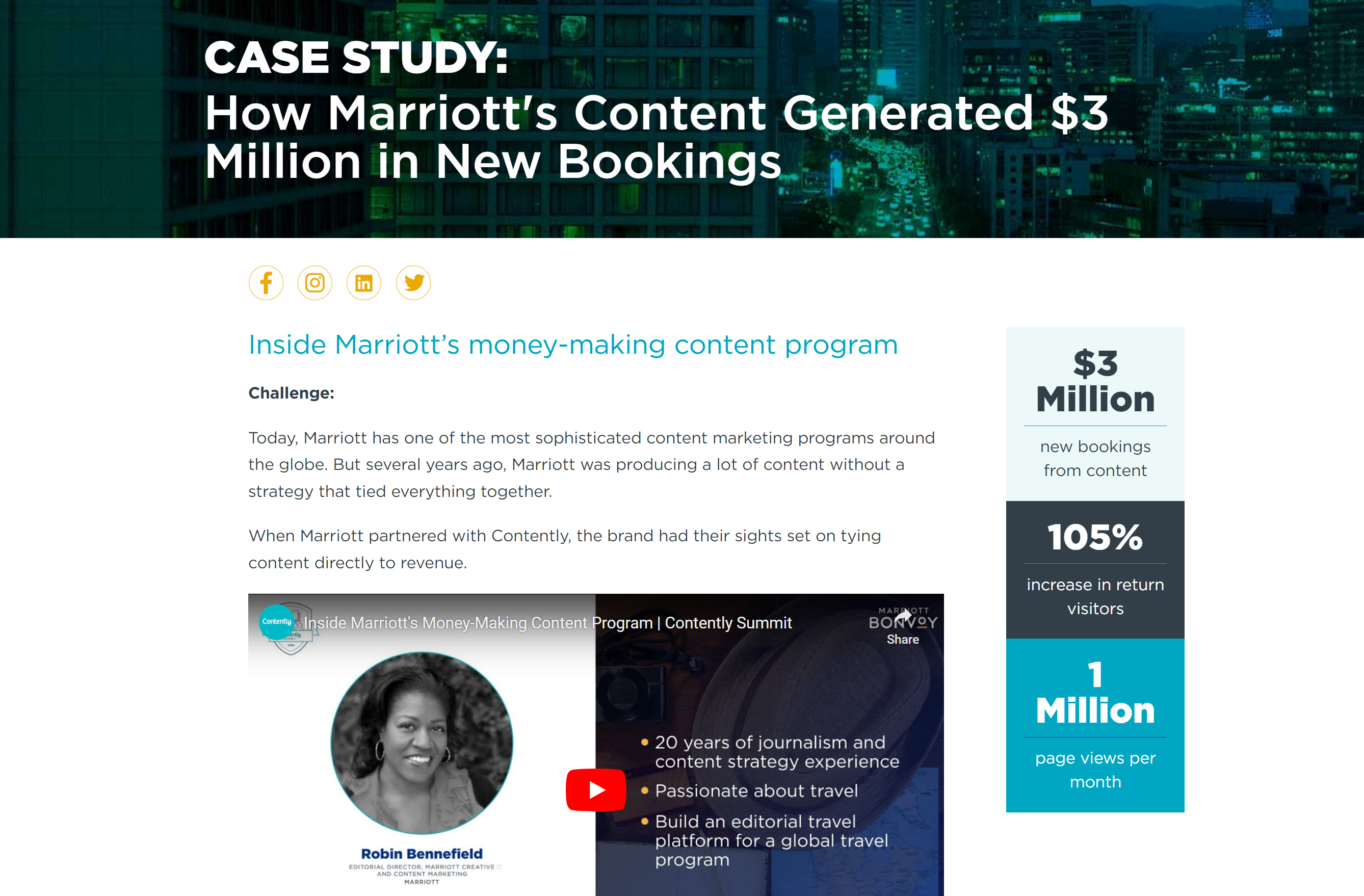
5) Wrap up with a customer highlight
As your case study draws to a close, take the opportunity to spotlight your customer’s opinion. This reinforces their success and happiness from their perspective, not just yours. It also validates everything you say in the case study and acts as powerful social proof.
Wrap up by sharing what the customer liked best about the experience, especially the solution and outcome. I like to title this section “the [company] advantage” and lead with a complimentary quote from the client. It’s a great strategy for summarizing the positives of the project and drives home the takeaway message you want the reader to remember.
While you should end with this highlight, be sure to add social proof from the customer throughout the piece as well. Sprinkle short quotes and testimonials from the client at suitable intervals. You could, for example, share their appreciation for how you helped them solve their challenge in the “problem” section of the case study to entice readers to keep reading and find out how you did it.
Below: MyFBAPrep wraps up case studies with a final customer testimonial and next steps.
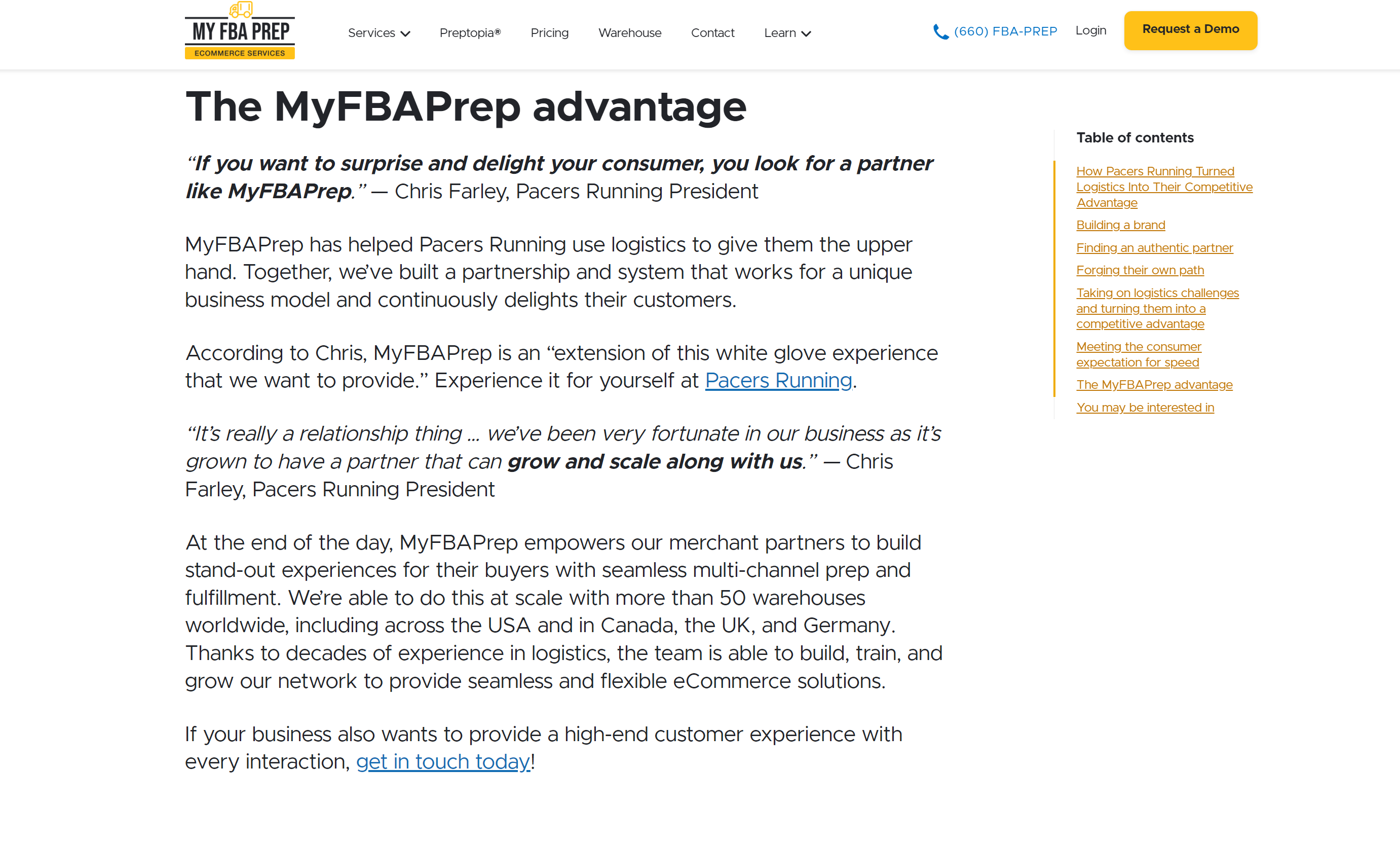
6) Share a compelling CTA
Finish the case study with a compelling call to action (CTA). Tell the reader what you want them to do next, rather than just crossing your fingers and hoping they act on their own.
Consider what next steps you want your readers to take, then make that your call to action. Do you want them to:
- Book a call with you?
- Fill out an enquiry form?
- Download a price list?
Choose a CTA that aligns with your commercial goal; after all, case studies are all about showing off the power behind your products or services.
Be specific and craft a CTA that speaks to the direct needs of your target audience. “Let’s talk about raising your conversion rate” is far more enticing than the bland “Contact us” alternative.
Below: HubSpot makes their final call to action stand out from the rest of the case study and uses simple language to drive a specific action.
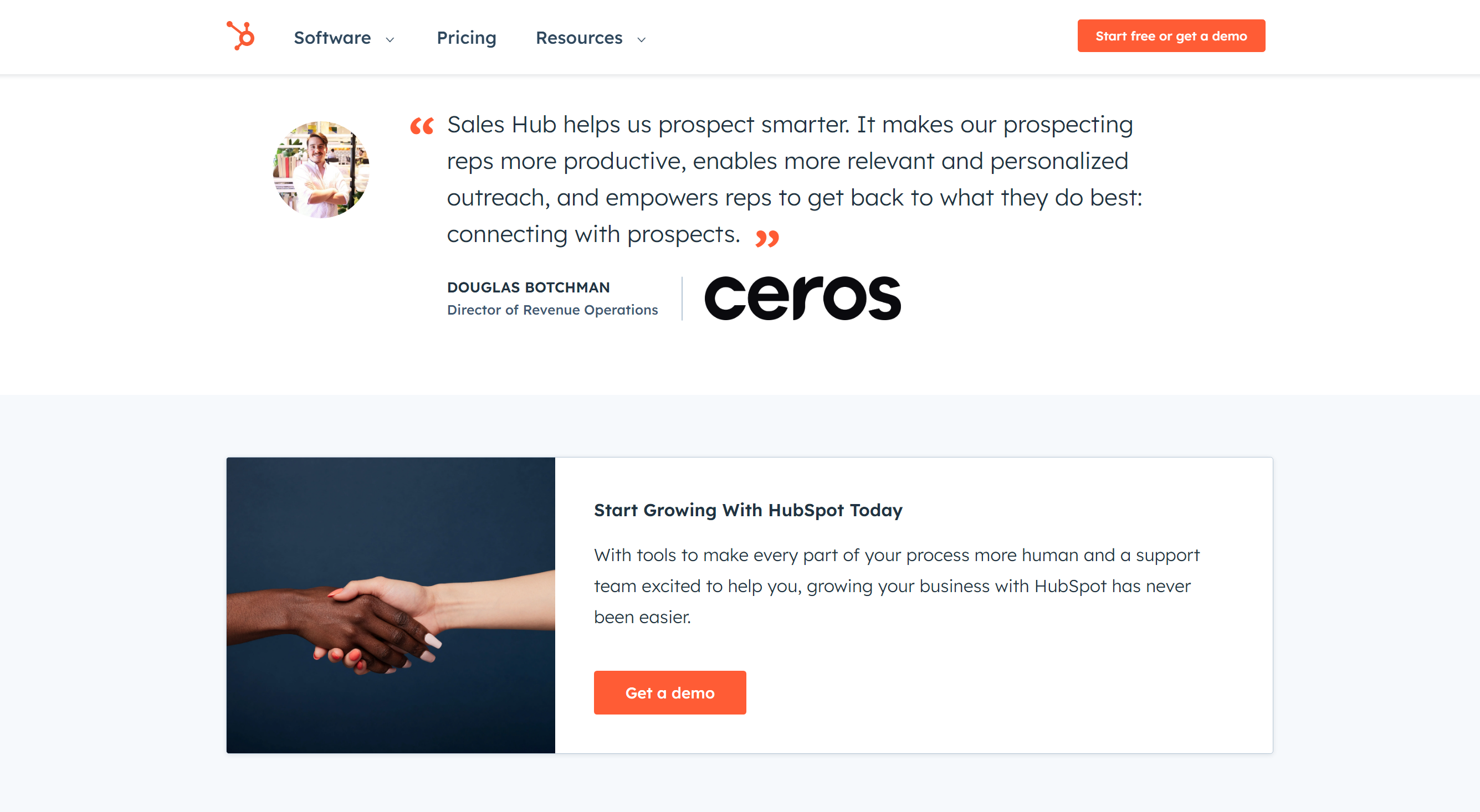
Wrapping up—Write a winning case study that drives leads
It’s easy for every business to make claims, but you can prove yours with case studies. Often, this makes the difference between a lost lead and a sale (particularly in B2B).
Creating a winning case study doesn’t have to be overwhelming. Choose your audience, identify the perfect customer story, and bring your case study to life with data, testimonials, and engaging visuals. Remember to close with an enticing and easily actionable CTA that inspires your readers to make their next move.
Do you want help putting together case studies? Reach out to learn how I can help by;
- Conducting client interviews
- Gathering internal data to paint a picture
- Writing a case study that attracts and converts leads